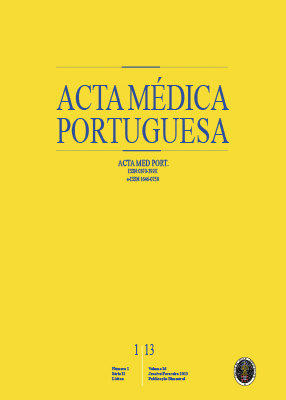Injuries Resulting from Positioning for Surgery: Incidence and Risk Factors
DOI:
https://doi.org/10.20344/amp.4006Abstract
Introduction: The appropriate surgical positioning is an essential step that is often underestimated, but must be considered, because can lead to serious but preventable injury. The objective of this study is to evaluate the incidence of injury due to surgical positioning, as well as try to identify their risk factors. Materials and Methods: Prospective study held for one year and included patients from different surgical specialties proposed for elective surgery. Patients were evaluated prior to surgery and exclusion criteria were: age < 18 years, American Society of Anesthesiologists - ASA score > III neuropathy or neuromuscular disease documented. Were considered injuries resulting from the positioning: erythema not reversible under digital pressure and/or persistent > 30 minutes, severe pain on pressure points and not related to the surgical site (Visual Analogue Scale - VAS ≥ 7) and peripheral nerve injury. We evaluated the following variables: sex, age, Body Mass Index, ASA classification, anesthetic technique, type of positioning, duration of surgery and its relationship with postoperative injury. Results: Of the 172 patients included in the study, perioperative lesions were identified in 12.2%, but five of these patients had more than one lesion (pain on pressure point + neuropathy). About 9.9% complained of severe pain (Visual Analogue Scale - VAS ≥ 7) on pressure points, 4.7% presented peripheral neuropathy and 0.6% had erythema that did not yield to the digital pressure. In the group that developed lesions, no significant difference with regard to age, sex, anesthetic technique, duration of surgery and positioning was found. Concerning to ASA classification, it was found that ASA II and III patients had a higher incidence of lesion (90.5%) compared with patients ASA I (9.5%), p < 0.05. The Body Mass Index > 30 Kg / m2 showed also statistically significant association with the development of postoperative injury, p < 0.001. In separate analysis of neuropathic injury was found that Body Mass Index > 30 Kg / m2 was associated with the occurrence of neuropathy, p < 0.05. Concerning the remaining variables and their relation with postoperative neuropathy, it wasn’t found a statistically significant relationship. Conclusion: The scientific evidence for prevention of injuries in the perioperative period, including the neuropathy is limited. The postoperative evaluation of patients is essential because it allows early recognition of lesions and its documentation and guidance. Keywords: Intraoperative Complications; Posture; Surgical Procedures, Operative; Wounds and Injuries/etiology.
Downloads
Downloads
Published
How to Cite
Issue
Section
License
All the articles published in the AMP are open access and comply with the requirements of funding agencies or academic institutions. The AMP is governed by the terms of the Creative Commons ‘Attribution – Non-Commercial Use - (CC-BY-NC)’ license, regarding the use by third parties.
It is the author’s responsibility to obtain approval for the reproduction of figures, tables, etc. from other publications.
Upon acceptance of an article for publication, the authors will be asked to complete the ICMJE “Copyright Liability and Copyright Sharing Statement “(http://www.actamedicaportuguesa.com/info/AMP-NormasPublicacao.pdf) and the “Declaration of Potential Conflicts of Interest” (http:// www.icmje.org/conflicts-of-interest). An e-mail will be sent to the corresponding author to acknowledge receipt of the manuscript.
After publication, the authors are authorised to make their articles available in repositories of their institutions of origin, as long as they always mention where they were published and according to the Creative Commons license.









